The Deep Time Walk – How Effective Is It?
Link to JSE March 2024 General Issue Table of Contents
Harding Woodford JSE March 2024 General Issue PDF
Abstract: At Schumacher College, Dartington, UK in 2008 we introduced the Deep Time Walk – a transformative learning experience in which college participants walk 4.6km in the countryside of the Dartington Estate representing the entire 4,600 million years of our planet’s history. The aim of the walk is to increase the ecological awareness of participants by giving them an embodied experience of the immense age of our Earth. At certain points during the walk a facilitator explains key events in earth history, such as the formation of the planet and the first appearance of living cells. Here we assess the effectiveness of the Deep Time Walk offered to eleven distinct groups of walkers during 2022 -2023. Participants on each of the eleven Deep Time Walks were asked to respond to a simple questionnaire asking them to quantify how much of seven qualities they felt immediately before and immediately after their walk (these were: Awe and Wonder, Sense of Earth’s Ancientness, Connection to Nature, Consequences of the Crisis, Hope, Commitment to Personal Change and Commitment to Political Change) . In total, 153 participants took part in the eleven walks and responded to the questionnaire. Analysis of the data showed a highly statistically significant increase across all seven qualities (p<0.00001 for each quality), suggesting that the Deep Time Walk is an effective means for developing and enhancing ecological awareness and commitment to action in these times of severe global crisis. Qualitative data were not collected during this phase of the study due to time limitations during walks. We recognise the importance of this kind of data and are devising ways of gathering it for both past and future walks.
Keywords: science communication, transformative learning, climate change communication, deep ecology, Gaia theory, walking pedagogies, Deep Time Walk
Introduction
It is now more and more evident that to solve the current climate and biodiversity ‘polycrisis’ humans need to relate to our planet in a totally different light, not as a dead machine, nor as an infinite well of resources and bottomless receptacle for our wastes, but rather as a living planetary entity within whom we live symbiotically (Harding, 2009). Just as microbes live in our guts, so do we live in the great body of our earth (Clarke, 2020; Matyssek, Lüttge and Castell, 2019). This immensely ancient perception of nature as alive (and full of soul) is the cornerstone of all indigenous perceptions of nature, including ancient Greece, the foundation of Western culture, where long ago Earth was experienced as Gaia, the Mother of All, the first born of primordial Chaos, that vast, mysterious intelligence (Baring and Cashford, 1993).
Transformative Education
Education is an important vehicle for shaping our world view, and yet much of our mainstream educational system produces people who promote the machine view of nature and hence the current catastrophic exploitation of her resources (Harding, 2021). Several alternative educational institutions have been established to counter this predominant mechanistic perception, one of which is Schumacher College, based on the Dartington Hall Trust estate in Devon, UK. The college was founded in 1990 to help small groups of people living together in community for periods ranging from one week to six months to enquire into the complex causes of the global crisis and how we might steer our way out of it. The college is a world leader in deeply ecological education which embraces experiential modes of learning that foster deep connection with Gaia, our living earth. It is now well recognised within the transformative learning literature that for ecological education to be effective it needs to engage learners’ Head, Heart and Hands, and that mere intellectual learning is not enough for solving the global crisis (Cranton, 2016; Kumar and Cenkl, 2021; Kumar and Howarth eds., 2022; O’Sullivan, 1999). The Deep Time Walk is one practice in which the pedagogy of the college offers learning with the intellect (via an integration of a range of disciples including biology, geology, hydrology, meteorology), whilst simultaneously opening the heart through the physical act of walking the immense age of the earth, engendering profound heart-body feelings of connection and commitment to taking peaceful action on behalf of our earth and all her beings, including humans. In this paper we analyse participants’ questionnaire responses from eleven Deep Time Walks facilitated by its ecologist Dr Stephan Harding, a founding faculty member at Schumacher College whose academic roles include researching and teaching Gaia Theory, Deep Ecology and Holistic Science.
The first course at Schumacher College in January 1991 was led by Professor James Lovelock, the distinguished inventor and scientist and author of Gaia Theory which proposes that key aspects of our planet’s surface such as her temperature and acidity are regulated within the narrow limits tolerable by life because of tight feedback loops between biological beings and our planet’s rocks, atmosphere and water (Lovelock, 2000). Stephan met James Lovelock on this first course, became his friend and collaborated with him scientifically for several years thereafter. Stephan took on the task of teaching Gaia Theory at the college and it was out of this work that the Deep Time Walk emerged as a contribution to the tradition of science-based contemplation of deep time pioneered by James Hutton (1726-1797), the father of modern geology in the 18th century (Hutton, 1788). In the field of education, it was the great Italian medical doctor and educator Maria Montessori (1870-1952), who based her entire educational approach for primary school children on her ‘cosmic education’ during which she unrolled a physical timeline of our planet’s development in the classroom which she walked alongside of with her pupils (Montessori, 1914 and 2008). Her aim was to evoke a consciousness in very young children of their life and place within the cosmic depths of time. This approach has been so successful that all Montessori educators to this day unroll and walk along deep timelines in their classrooms with their pupils.
Having studied geology for a year as an undergraduate in the early seventies, Stephan knew about deep time intellectually, but never truly experientially in ways involving heart, soul and science which Maria Montessori would no doubt have appreciated. This wider perceptual opening into deep time happened for him many years later when Joanna Macy was teaching at Schumacher College in the early 1990s. Joanna set up a deep time spiral on the college lawn covering a distance of around 100m. Stephan and fellow participants traversed along the spiral whilst the soothing cadence of Joanna’s voice took them into the deep time history of humanity’s presence on our Earth (Macy, 1993; Macy and Brown, 2016). This resulted in Stephan having a profound deep experience, an awakening into the palpable, livingness of our planet, into what one might characterise as the livingness of Gaia (Harding, 2020).
For many years after that initial deep time experience with Joanna Macy, Stephan had been taking participants of college courses for walks along England’s South West coast path from Little Dartmouth to Dartmouth during which we contemplated the wonder and complexity of our animate earth, but otherwise with no explicit focus. One participant who enjoyed these walks was Sergio Maraschin, a senior geologist who had come to study on the college’s MSc in Holistic Science, founded by biologist Brian Goodwin, Professor Emeritus at the Open University, and Stephan.
Developing the Deep Time Walk
Inspired during many conversations about holistic science, education, Gaia theory, ecology and geology, Sergio and Stephan soon found themselves collaborating in establishing the first Deep Time Walk along the coast path from Little Dartmouth to Dartmouth – a walk covering a distance of 4.6km (4,600 meters) which represents the 4,600 million years since Earth and our solar system appeared to the present day, each metre representing 1 million years.
Several years later, Robert Woodford came to the college to study on the MA in Ecological Economics. Robert was deeply moved by the Deep Time Walk and was inspired to dedicate his time to championing, disseminating, and creating a range of resources and materials that would empower other people to experience the walk, enabling educators and community leaders to start animating their own Deep Time Walks, thereby seeding the experience across the world. In the process, Robert (along with Geoff Ainscow) masterminded the creation of the Deep Time Walk app, the Deep Time Cards and was the lead author of both the ‘Earth Stations’ document – (a practical guide for narrating a Deep Time Walk) and ‘Holding Space’ (a Head-Heart-Body guide to facilitating a Deep Time Walk experience). Together, Robert, Geoff and Stephan co-founded the Deep Time Walk CIC in 2016, a not-for-profit which continues to offer a range of resources and training courses for those interested in leading a Deep Time Walk in their educational institutions, communities, or organisations (https://www.deeptimewalk.org).
With over fifteen years’ experience leading Deep Time Walks for over 70 groups, Stephan has noted qualitatively how many participants experienced our planet as profoundly alive, animate, and in some way sentient as a result of the walk. Robert also received a range of anecdotal feedback from the Deep Time Walks that he has led in person with organisations where participants expressed a number of positive changes in their understanding of the place of the human in the more-than-human world. Together, Stephan and Robert realised that it would be helpful to explore how a Deep Time Walk experience changes participants’ ecological perceptions and how these effects could be demonstrated both qualitatively and quantitively. Hence our collaboration in carrying out this quantitative study of the effectiveness of the Deep Time Walk experience. Data on participant’s qualitative perceptions of the walk (possibly using Arts Informed research methods such as those described in Knowles and Cole, 2008) will be gathered in future and compared with the quantitative data described in this paper.
Materials and Methods
The walk
The data explored here were collected by Stephan between December 2022 and September 2023 during eleven Deep Time Walks he facilitated for eleven separate groups involving a total of 153 participants (Table 1). Seven of the groups were either volunteers or postgraduate students at Schumacher College. The remaining four groups came from diverse areas from beyond the college to engage in its radical educational experiences. All the participants in this study had a strong interest in learning about ecology and the current ecological/climate crisis and its solutions.
Each of the eleven Deep Time Walks in this study took place on the same 4.6km route on the Dartington Hall Trust’s estate in South Devon where Schumacher College is located. The route passes through relatively undisturbed nature for most of its length, traversing woods, pastures, riverine habitats and, at the very end, the formal, highly curated Dartington Hall gardens.
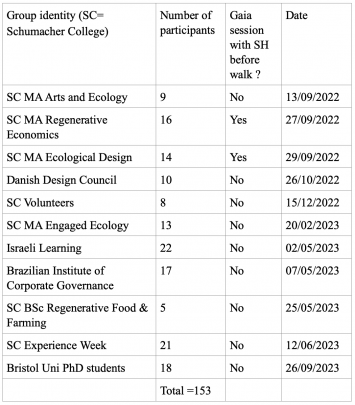
Table 1. Details of the groups participating in this study. A Gaia session is a 90 minute classroom session with SH exploring the myth and science of Gaia.
Earth Stations and Exercises
At the starting point of each walk, before sharing any scientific details, Stephan gave a brief introduction explaining how the 4.6km of the walk represents the full 4,600 million years (4.6 billion years) of Earth history. He laid down a tape measure and walked alongside it, showing how, on this scale, each metre is one million years, each footstep is 500 million years and each millimetre one thousand years. Stephan noted how these basic facts never failed to elicit responses of surprise, awe and wonder from the participants. He explained how the walk started in the deep past 4,600 million years ago, and that we would walk towards the present day, some 4.6km distant. He requested that participants keep any conversations flowing along ecological lines and said that at times we would be walking in silence, mindful of deep time.
Along the route Stephan invited participants to stop at different points in earth history represented by the distance travelled and measured in millions of years ago (MYA) – these points were later named as ‘Earth Stations’ by Robert. At these stopping points Stephan described important events that occurred during the unfolding story of our earth as revealed by the sciences of the earth. At some Earth Stations Stephan introduced group activities and meditations to enhance the experience, such as a celebration with virtual champagne when first life appears, the acting out by the group of the formation of the first eukaryotic cells or inviting participants to lie with their backs on the ground and feeling the great earth dangling them upside down over the cosmos. At the end of the walk Stephan aligned a 30cm (300mm= 300,000 years) ruler along the trajectory of the walk and told participants the story of the final 300,000 years of Earth’s history at which point our species, Homo sapiens, appeared. On this scale the last glaciation ended 11.7mm (11,700) years ago; the farming revolution began roughly 8mm (8,000) years ago; recorded history began in Egypt and Mesopotamia 6mm (6,000) years ago, with the first monotheistic religions appearing roughly 2mm (2,000) years ago. Participants were astonished to see that the industrial revolution, which began some 200 years ago, covered only the last 0.2mm (1/5th of a millimetre) of the walk, giving rise to the current polycrisis.
Questionnaire
For the purposes of this study, Stephan and Robert devised a simple questionnaire consisting of seven ‘statements’ to which the participants responded before and immediately after the walk (Table 2).
Harding Woodford Table 2 Full PDF
The Schumacher College MA Arts and Ecology group was the first to be trialled with the questionnaire, so they were not asked to respond to three statements which were added later and given to all the other groups. The statements not given to the MA Arts and Ecology group were: Sense of Earth’s Ancientness, Consequences of the Crisis and Hope.
The statements given to all the groups were arranged under two headings or themes: Gaia and The Global Crisis. The sequence of the seven statements was based on Arne Naess’s Apron Diagram, (Naess, 2008), transposed by his friend and student Per Ingvar Haukeland into the Ecosophical Tree (Haukeland, 2023). The sequence flows from the roots of the Tree – our deep experiences of Gaia, into the trunk: our conscious perception of the planetary consequences of our modern lifestyles and our hopes for the future. Next, the branches and fruits represent a person’s commitment to personal lifestyle change and for engaging in systemic political and cultural change. The sequence of statements (apart from the MA in Arts and Ecology, as described above) was as follows:
Participants were asked to record how much of the quality of each statement (such as ‘how much awe and wonder’) they experienced immediately before and immediately after the walk on an A4 paper data sheet on which a 115mm long straight line was printed next to each statement. Stephan explained that a mark to the left on a line indicated a low amount of that statement’s quality in their current perception, whilst a mark to the right on the line indicated a high degree of the quality. We used a line rather than a discrete number scale because statistically this fits best with the requirements of the Wilcoxon signed rank test used to analyse the data and because we felt this would give participants maximum freedom for expressing their perception of each statement’s quality immediately before and immediately after the walk. Marks on lines were later measured in millimetres by Stephan and Robert, giving the numerical values used for the statistical analysis described below.
Results
Figure 2 graphs the results of our preliminary analysis using box and whisker charts of the ‘before; and ‘after’ combined responses of the 153 participants of the eleven groups on the eleven Deep Time Walks in this study.
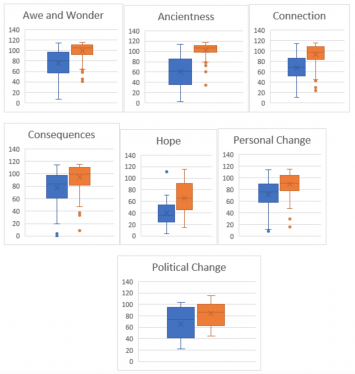
Figure 2. Box and whisker charts of the data across all the groups for each statement before (blue) and immediately after (orange) all eleven the deep time walks combined. There were highly statistically significant increases in all seven statements immediately after the walk (p<0.00001 in all cases). The middle line of the box in each chart represents the median or middle value. The ‘x’ in the box represents the mean value. The median divides the data set into a bottom half and a top half. The bottom line of the box represents the median of the bottom half or 1st quartile. The top line of the box represents the median of the top half or 3rd quartile. The box covers 50% of the values when arranged in order. The Inter Quartile Range (IQR) is the difference between the top and bottom medians. A data point is considered an outlier if it exceeds a distance of 1.5 times the IQR below or 1.5 times the IQR above the 3rd or below the 1st quartile. These values are represented by the ‘whiskers’. The dots represent outliers beyond these values.
We used a two tailed Wilcoxon signed rank test to compare the ‘before’ and ‘after’ measurements for each statement without discriminating between the groups – that is, by combing all the data from all eleven groups into one overall data set. This test was chosen because there is no requirement for the data to be normally distributed and because it deals with values matched as ‘before’ and ’after’ pairs for each participant. The results are striking: all the tests revealed highly statistically significant differences at p<0.00001 across the board between ‘before’ and ‘after’ statements.
Discussion
The statistical analyses showed a highly significant increase for each of the seven statements immediately after the walks when the data for all eleven walks were combined (p<0.00001 for each statement). This means that one would expect to find these results by chance in one out of ten thousand such data sets. Thus, we have a very high degree of confidence that the Deep Time Walk experience was immensely effective in increasing and enhancing overall ecological perceptions and willingness to engage in both personal lifestyle change and political advocacy in our group of 153 participants immediately after the walk.
The Deep Time Walks enhanced participants’ perception of our planet’s Ancientness most of all, with Awe and Wonder coming a close second in perceptual impact and Connection coming in third. Consequences, Hope, Personal Change and Political Change showed more perceptual overlap before and after the walks than was the case for the first three statements, with Political Change showing the smallest difference, although it must be remembered that the ‘before’ and ‘after’ differences for each statement were all highly statistically significant.
However, the study cannot answer a range of critical questions, namely to what extent such results might be obtained due to a number of factors including the experience of the facilitator, the specific route of the walk, the dynamic of the group, the predisposition of the group to ecological ideas and the weather at the time of the walk. It will be important therefore to explore these factors in the future by extending the scope of the research.
This study permits us to conclude that the Deep Time Walk is a highly effective tool for significantly enhancing the ecological perceptions of individuals with pre-existing concerns about the state of our earth and for motivating them to engage in personal and collective actions to protect our planet.
Whether the Deep Time Walk can motivate people with no prior major concerns about the ecological/climate crisis is an important area for further research, but initial results from a small number of organisations using this questionnaire carried out by Robert suggests that this might be the case. Thus, it seems worthwhile to offer the Deep Time Walk to groups all over the world.
References
Baring, A and Cashford, J. (1993). The Myth of the Goddess. Evolution of and Image. Arkana, Penguin Books.
Castell, W., Lüttge, U & Matyssek, R. (2019) Gaia – A Holobiont-like System Emerging From Interaction. In: Emergence and Modularity in Life Sciences. pp. 255-279 Lars H. Wegner, L.H. and Lüttge, U.(eds.) Springer Verlag.
Clarke, B. (2020). Gaian Systems. University of Minnesota Press.
Cranton, P. (2016, 3rd ed.). Understanding and Promoting Transformative Learning: A Guide to Theory and Practice. Stylus Publishing.
Harding, S.P. (2009, 2nd ed.) Animate Earth: Science, Intuition and Gaia. Green Books/Bloomsbury.
Harding, S.P. (2020). Gaia Consciousness in the Great Turning. In: A Wild Love for the World, Joana Macy and the Work of Our Time. pp. 11-18. Kaza, S. (ed.) Shambhala.
Harding, S.P. (2021). Teaching for Gaia. In: Transformative Learning. Reflections on 30 Years of Head, Heart and Hands at Schumacher College. pp. 19-26. New Society Publishers.
Haukeland, P.I. (2023) Becoming Home: Revisiting Arne Naess: Toward an Ecophilosophy and a Depth Ecology for the 22nd Century. The Trumpeter 39, No.1.
Hutton, J. (1788 and 2010). Theory of the Earth. CreateSpace Independent Publishing Platform.
Knowles, J.G and Cole, A.L, eds.(2008) Handbook of the Arts in Qualitative Research: Perspectives, Methodologies, Examples, and Issues. Sage Publications.
Kumar, S. and Cenkl, P. (2021). Transformative Learning. Reflections on 30 Years of Head, Heart and Hands at Schumacher College. New Society Publishers.
Kumar, S. and Howarth, L. eds. (2022) Regenerative Learning. Nurturing People and Caring for the Planet. Global Resilience Publishing.
Lovelock, J.E. (2000 2nd. ed.). The Ages of Gaia. Oxford University Press.
Macy, J. (1993) World as Lover, World as Self, pp 231-232. Rider, London
Macy, J. and Brown, M. (2016) Coming Back to Life. pp 175-182. New Society Publishers.
Montessori, M. (1914 and 2008). Montessori’s Own Handbook: Maria Montessori’s Original Guide on the Learning Environment and Development of Children. Read & Co. Books.
Naess, A. (2008). Ecology, Community and Lifestyle: Outline of an Ecosophy. Cambridge University Press, Reprint Edition.
O’Sullivan, E. (1999) Transformative Learning: Educational Vision for the 21st Century. Zed Books.







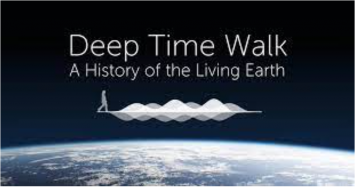
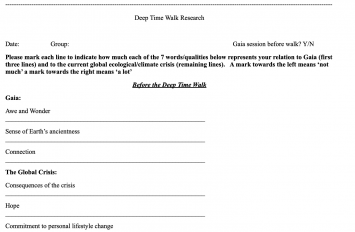
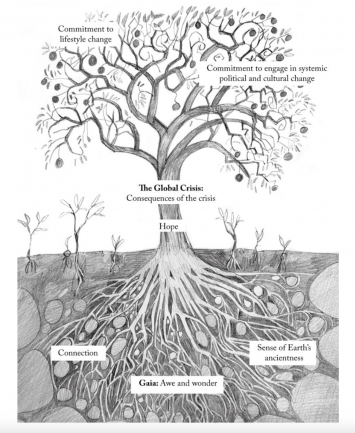



 Stephan Harding holds a degree in zoology from the University of Durham and a doctorate in behavioural ecology from the University of Oxford. He has ecological research experience in Africa and Latin America, where he was a founding professor of the Instituto Internacional en Conservacion y Manejo de Vida Silvestre at the National University of Costa Rica. He is a founding faculty of Schumacher College where he is currently the Deep Ecology Research Fellow. researching the connections between Gaian science, spirituality and deep ecology. s.harding (at) schumachercollege.org.uk
Stephan Harding holds a degree in zoology from the University of Durham and a doctorate in behavioural ecology from the University of Oxford. He has ecological research experience in Africa and Latin America, where he was a founding professor of the Instituto Internacional en Conservacion y Manejo de Vida Silvestre at the National University of Costa Rica. He is a founding faculty of Schumacher College where he is currently the Deep Ecology Research Fellow. researching the connections between Gaian science, spirituality and deep ecology. s.harding (at) schumachercollege.org.uk  Robert Woodford is co-founder of the Deep Time Walk Project. He has a degree in music from Durham University, an MA Management from Durham Business School, an MA Regenerative Economics from Schumacher College (Plymouth University) and an MSc in Science & Religion from Edinburgh University. He previously worked in senior positions with Macromedia/Adobe and Qualcomm, and now works on a range of creative initiatives bridging the areas of climate change and ecology through his consultancy Opus Earth. robert (at) deeptimewalk.org
Robert Woodford is co-founder of the Deep Time Walk Project. He has a degree in music from Durham University, an MA Management from Durham Business School, an MA Regenerative Economics from Schumacher College (Plymouth University) and an MSc in Science & Religion from Edinburgh University. He previously worked in senior positions with Macromedia/Adobe and Qualcomm, and now works on a range of creative initiatives bridging the areas of climate change and ecology through his consultancy Opus Earth. robert (at) deeptimewalk.org 
